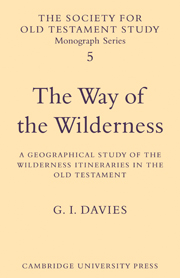Book contents
- Frontmatter
- Contents
- Preface
- Abbreviations
- Maps
- 1 Introduction
- 2 Jewish interpretations in Greek
- 3 Jewish interpretations in Hebrew and Aramaic
- 4 Christian interpretations
- 5 Arabic interpretations
- 6 Behind the traditions
- 7 Key points on the routes
- 8 Routes in the Sinai Peninsula
- 9 Identification of the routes described
- Notes to the text
- Bibliography and Author Index
- Indexes
- Frontmatter
- Contents
- Preface
- Abbreviations
- Maps
- 1 Introduction
- 2 Jewish interpretations in Greek
- 3 Jewish interpretations in Hebrew and Aramaic
- 4 Christian interpretations
- 5 Arabic interpretations
- 6 Behind the traditions
- 7 Key points on the routes
- 8 Routes in the Sinai Peninsula
- 9 Identification of the routes described
- Notes to the text
- Bibliography and Author Index
- Indexes
Summary
Among the geographical texts in the Pentateuch the wilderness itineraries form a group which provide especially precise information and share an unusually similar structure. The longest and most complete example is found in Num. 33: 1–49, but parallels to parts of this passage exist in a series of isolated verses in the main narrative of Exodus and Numbers, which show agreement with it in content and structure, and often in verbal details as well (e.g. Ex. 12: 37a). Shorter itineraries are to be found in Num. 21: 12–20 and Dt. 10: 6–7. These passages belong, from the point of view of their form, to a widely attested literary genre of the ancient world, which survives mainly in official documents. It is probable that this way of presenting a route was borrowed by the writers of the Old Testament from the repertoire of the archives of the Israelite royal court.
In view of their primary function – which is to describe routes – it is only to be expected that the geographical significance of the wilderness itineraries would be a topic of continuing interest to readers and interpreters of the books in which they occur. It is certainly this aspect of the texts which has received the greatest attention from scholars in the modern period, to the neglect, it must be said, of other features such as their formal characteristics.
- Type
- Chapter
- Information
- The Way of the WildernessA Geographical Study of the Wilderness Itineraries in the Old Testament, pp. 1 - 3Publisher: Cambridge University PressPrint publication year: 1979



